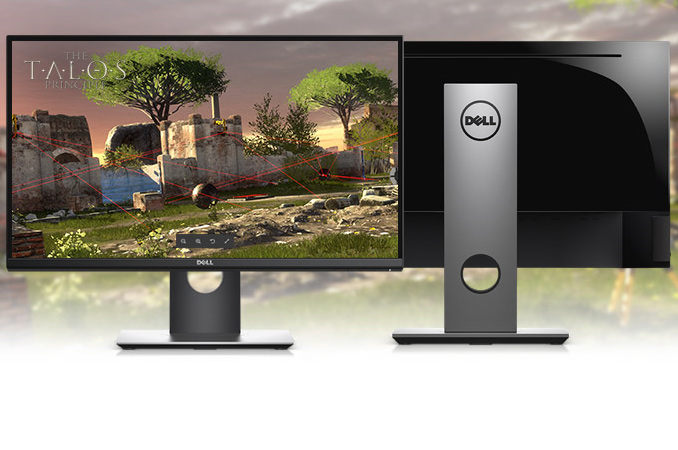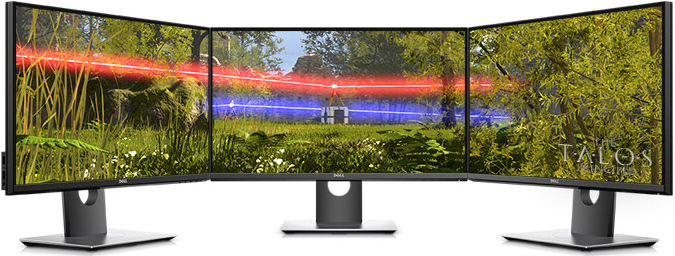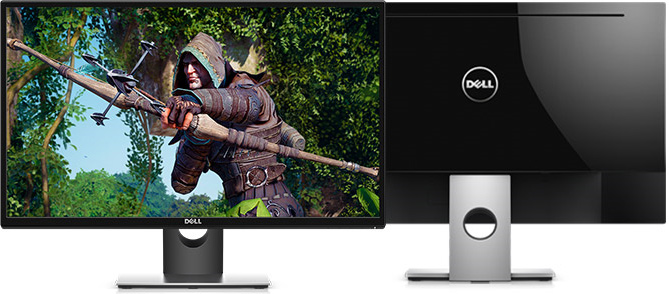Dell Releases S2417DG and SE2717H Monitors: New Gaming Displays with G-Sync and FreeSync
by Anton Shilov on August 8, 2016 7:00 AM EST
Dell has quietly expanded its lineup of gaming displays with two new monitors featuring dynamic refresh technologies from AMD and NVIDIA. One of the monitors uses a full-HD (1920x1080) IPS panel with a refresh rate up to 75 Hz, whereas the other has a WQHD (2560x1440) TN panel with a refresh rate up to 165 Hz. The products belong to the entry-level and mainstream segments.
The Dell S2417DG is a monitor that the supplier recently added to its web-site in various locals but not via an official press release at this point. The S2417DG is based on a 23.8” TN panel with a 2560×1440 resolution, a peak brightness of 350 nits as well as a 1000:1 contrast. The key advantage of the S2417DG display for gamers is support for NVIDIA’s variable refresh rate G-Sync technology, allowing dynamic refresh rates between 30 and 165 Hz, which is a very decent range for a WQHD monitor. Moreover, with such high peak refresh rate, it is possible to use the monitor for stereoscopic 3D gaming using NVIDIA’s 3D Vision 2 glasses. Since this one uses a TN panel, this display is not aimed at professionals and exchanges refresh rate for color accuracy and viewing angles (it supports 170°/160° horizontal/vertical. For inputs, the monitor has DisplayPort and HDMI connectors to allow gamers to switch between a PC and a game console. In addition, the S2417SG has a quad-port USB 3.0 hub as well as an ultra-thin bezel for setting up multi-monitor arrangements.
The price of the Dell S2417DG is not listed by the supplier, but TFTCentral reports that the product will cost $570 when it is available later this quarter, which is $100 below its bigger brother, the S2717DG. The very decent dynamic refresh rate range between 30 and 165 Hz in the WQHD form factor is a large factor in the cost of the monitor.
| Specifications of Dell's S2417DG and SE2717H Displays | ||||
| S2417DG with G-Sync and ULMB |
SE2717H with FreeSync |
|||
| Panel | 23.8" TN | 27" IPS (6 bit + FRC) | ||
| Resolution | 2560 × 1440 | 1920 × 1080 | ||
| Max Refresh Rate | 165 Hz | 75 Hz | ||
| Refresh Rate Range | 30 Hz - 165 Hz | 48 Hz - 75 Hz | ||
| Response Time | 1 ms gray-to-gray | 6 ms gray-to-gray | ||
| Brightness | 350 cd/m² | 300 cd/m² | ||
| Contrast | 1000:1 | 1000:1 | ||
| Viewing Angles | 170°/160° horizontal/vertical | 178°/178° horizontal/vertical | ||
| PPI | 123.44 ppi | 82 ppi | ||
| Pixel Pitch | unknown | 0.3114 mm | ||
| Colors | 16.7 million | 16.7 billion | ||
| Color Saturation | unknown | 84% (CIE 1976) 72% (CIE 1931) |
||
| Inputs | DisplayPort 1.2a HDMI 1.4 |
HDMI 1.4 D-Sub |
||
| Audio | 3.5 mm input/output | none | ||
Up next is the Dell SE2717H, which the company recently added to its U.S. Hong Kong web-site. The monitor looks to be a budget solution for gamers, as it costs HK$1799 (about $232) in Hong Kong and does not boast a high-end specification. Right now, it is not completely clear when this monitor is set to be available in Europe, but in the U.S. it is going to be available starting from August 16 for $250.
The SE2717H display is based on a 27” 1920x1080 IPS panel with a peak brightness of 300 nits as well as 178°/178° horizontal/vertical viewing angles. To appeal to gamers, it supports AMD’s FreeSync dynamic refresh rate technology in the range between 48 Hz and 75 Hz, which is standard for monitors in this class. The display has one HDMI 1.4 input (which makes it one of the first FreeSync-supporting screen with an HDMI input) as well as a D-Sub to connect to older PCs.
The addition of AMD’s FreeSync technology to a budget display indicates that this feature should start to roll out to standard gaming monitors rather than a remaining premium capability. While the SE2717H is not the cheapest FreeSync-supporting monitor around, at 1080p with a 27” panel and a 75 Hz maximum refresh rate (as opposed to 60 Hz in case of cheap screens), theses advantages that are going to attract the attention of potential buyers.
Sources: Dell, Dell, TFTCentral.


















45 Comments
View All Comments
Black Obsidian - Monday, August 8, 2016 - link
I'll echo crimsonsun, as someone who has a pretty similar rig. My Dell 34" 21:9 panel is fantastic for productivity, and even for gaming I'll take greater immersion and a solid 60fps over a lower-quality panel that can go faster for no particular benefit.FreeSync might have been nice to gracefully handle sub-60fps, but since it's effectively free and everybody but nVidia does or will support it, I'm expecting it will show up in the next refresh of the majority of Dell's monitors, at least above the entry-grade E-series. And in the meantime, my 980Ti ensures that sub-60fps happens pretty rarely.
DanNeely - Monday, August 8, 2016 - link
Has Intel followed up on last years commitment to add Freesync support yet, or do we need to wait for future drivers/CPU architectures to add it?Black Obsidian - Monday, August 8, 2016 - link
If I recall correctly, FreeSync requires DisplayPort 1.3, and Skylake supports only 1.2, so we'll need to wait for future CPU architectures.There's no definitive word on what Kaby Lake support looks like, but given that it's an interim release shoehorned between the traditional "tick" and "tock", it's not entirely unreasonable to expect that DP1.3/FreeSync support might not come along until Cannonlake in 2H 2017.
extide - Monday, August 8, 2016 - link
I don't think so, because Hawaii/Fiji only support DP 1.2. I think it's in either 1.1 or 1.2DP 1.3 added the HBR3 signal mode which only Polaris and Pascal support right now. DP 1.4 was a feature update, but still used the same signalling standards.
Ryan Smith - Monday, August 8, 2016 - link
Technically it's 1.2a. But DisplayPort Adaptive Sync is not a requirement at any level, so even a newer 1.3/1.4 controller is not guaranteed to support it.Sivar - Monday, August 8, 2016 - link
I had for years and eventually went with some Dell IPS non-GSync monitors during a sale.It is either very difficult to create a high-refresh IPS or the market demand isn't there. Or both. It's too bad since IPS look so much better than TN.
Flunk - Tuesday, August 16, 2016 - link
The panels just don't exist in the market. You can get PVA panels, which is more similar to IPS than TN but suffers from slightly less vibrant colors but also have deeper blacks as high as 120hz. But based on the products I see those panels in I think they're pricey.Chaitanya - Monday, August 8, 2016 - link
Acer XF270HU, and EIZO FORIS FS2735 are the two monitors that fit your requirement. In general it seems like there are more Freesync monitors out in market and Users of AMD cards can be picky while nVidia users are left to chew the dust with very little choice of G-Sync monitors and also more expensive monitors. While I can get IPS Freesync monitor with RX-480 for under 500$ there are no similarly priced or Nvidia options.mdriftmeyer - Monday, August 8, 2016 - link
Just looking at the specs Dell is playing a cat and mouse game. Some specs better for each over the other. I wouldn't buy either. GSync has higher PPI, but a poorer quality panel.Xanavi - Monday, August 8, 2016 - link
I bought the Acer XB240H, 1080p 144hz TN for $299. Happy camper :)